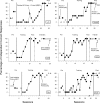Using complex auditory-visual samples to produce emergent relations in children with autism
- PMID: 20808504
- PMCID: PMC2831442
- DOI: 10.1901/jaba.2010.43-131
Using complex auditory-visual samples to produce emergent relations in children with autism
Abstract
Six participants with autism learned conditional relations between complex auditory-visual sample stimuli (dictated words and pictures) and simple visual comparisons (printed words) using matching-to-sample training procedures. Pre- and posttests examined potential stimulus control by each element of the complex sample when presented individually and emergence of additional conditional relations and oral labeling. Tests revealed class-consistent performance for all participants following training.
Keywords: autism; complex sample; conditional discrimination; matching to sample; stimulus equivalence.
Figures
References
-
- Green G, Saunders R.R. Stimulus equivalence. In: Lattal K.A, Perone M, editors. Handbook of research methods in human operant behavior. New York: Plenum; 1998. pp. 229–262.
-
- LeBlanc L.A, Miguel C.F, Cummings A.R, Goldsmith T.R, Carr J.E. The effects of three stimulus-equivalence testing conditions on emergent US geography relations of children diagnosed with autism. Behavioral Interventions. 2003;18:279–289.
-
- Maguire R.W, Stromer R, Mackay H.A, Demis C.A. Matching to complex samples and stimulus class formation in adults with autism and young children. Journal of Autism and Developmental Disorders. 1994;24:753–772. - PubMed
MeSH terms
LinkOut - more resources
Full Text Sources


